Choosing the perfect sink for your kitchen layout can be overwhelming because of the options available in the market. Don’t worry!
We have made this overwhelming process -easy for you. The kitchen and perhaps kitchen sink is the most used place in our homes. And hence, it is crucial to select the perfect sink.
Today, we will discuss 17 different kitchen sink types and weigh their merits and demerits based on the factors such as price, cleanliness, maintenance, and usage.
According to Material | According to Design | According to Installation
List of Different Types
Before selecting a kitchen sink, it is constantly bombarded with dirt and debris such as food buildup, liquid spills, and so on.
Therefore, for your assistance, let us go through 17 different kitchen sink types and their merits and demerits to help you make the right decision for your kitchen.
According to The Material:
Before discussing the kitchen sink types, let us quickly go through what materials are available in sinks. Kitchen sinks are available in various materials. Some of the materials listed below are durable, scratch-resistant, while others are delicate and fit for minimum usage.
- Stainless steel
- Granite
- Marble
- Quartz
- Porcelain
- Fire clay
- Cast iron
- Copper
Stainless steel, cast iron, composite granite are by far the best kitchen sink materials you can have in your kitchen layout.
There are various sinks materials to choose from, but let us look at the most recommended sink materials for the kitchen particularly.
Stainless Steel
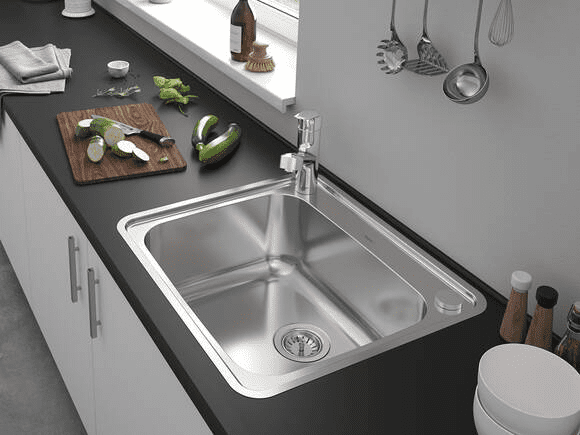
Till today, stainless steel sinks have been the most popular in kitchens. Stainless steel sink creates a streamlined, modern design and works well with granite, marble, or wood countertops. According to the leading manufacturer, Franke, 70% of sinks are made out of stainless steel.
Especially for the kitchen, select the 300 series steel having 16 to 18 gauge steel (thickness of the steel). The reason is, it is not magnetic and, at high temperatures, it can prevent corrosion or rust.
Did you know: Report says nearly $1.38B worth of trade in stainless steel sinks and washbasins, placing it in 1654th place in terms of world trade in the year 2019
Merits
- Easy clean
- Affordable
- Heat and stain-resistant
Demerits
- Noisy
- Develops hard water deposits
- Material can dent
SUMMARY: Stainless steel is perfect for kitchens as it is easiest to clean and budget-friendly. Besides, other than being noisy, it is the best choice you will make for your kitchens.
Stone -Granite and Marble
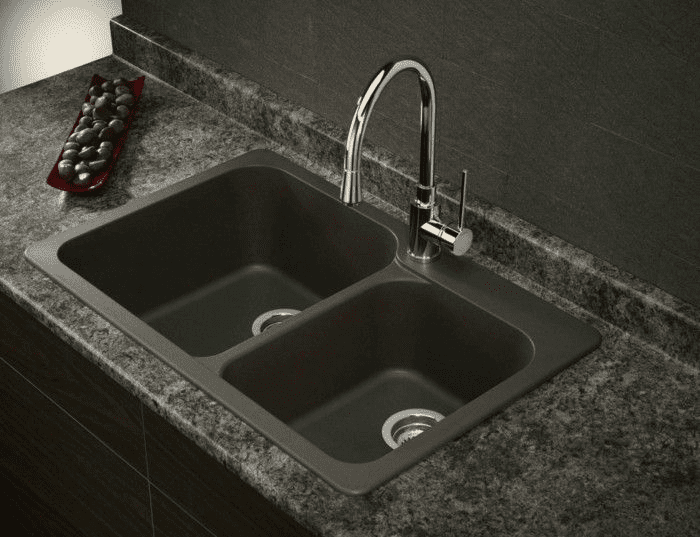
Right now, granite is available in a variety of pure granite (100%), pure marble (100%), composite of quartz granite (85%) and resin(15%), and cultured marble.
According to the Grand Review Research report of 2019, people prefer granite over metallic material for kitchen sinks. Why? Because they are scratch-resistant, unlike other metallic materials.
Also, granite is porous and requires special cleaning agents that do not include bleach or other chemicals.
Merits
- Slightly expensive
- Durable
- Customizable
Demerits
- Heavy
- May chip or crack
- Need extra care and maintenance
SUMMARY: If you are willing to put in some effort in maintaining your sinks, stone sinks such as granite and marble will be a better option for you.
Quartz
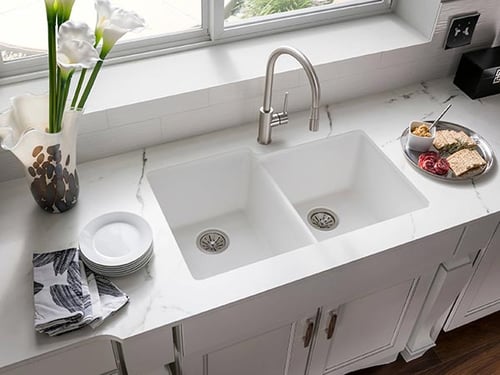
An eco-friendly material, Quartz is gaining popularity over time for being functional, inexpensive, and the perfect design for your modular kitchens. Unlike granite or marble, quartz sinks are non-porous. And hence, require less maintenance.
Besides being easy to maintain, it also is resilient to scratches, stains, and heat (up to 530°C). Quartz is made by combining quartz crystals and acrylic resin to sustain any wear and tear that comes its way.
Merits
- Vibrations and noise absorbing
- Hygienic
- Affordable
Demerits
- Susceptible to chipping
- Limited colors and only comes in matte finish
- Dark-colored sinks might suffer some wear and tear
SUMMARY: If you are looking for a more practical and functional material, quartz might be the best material to have in your kitchen.
Porcelain and Ceramic
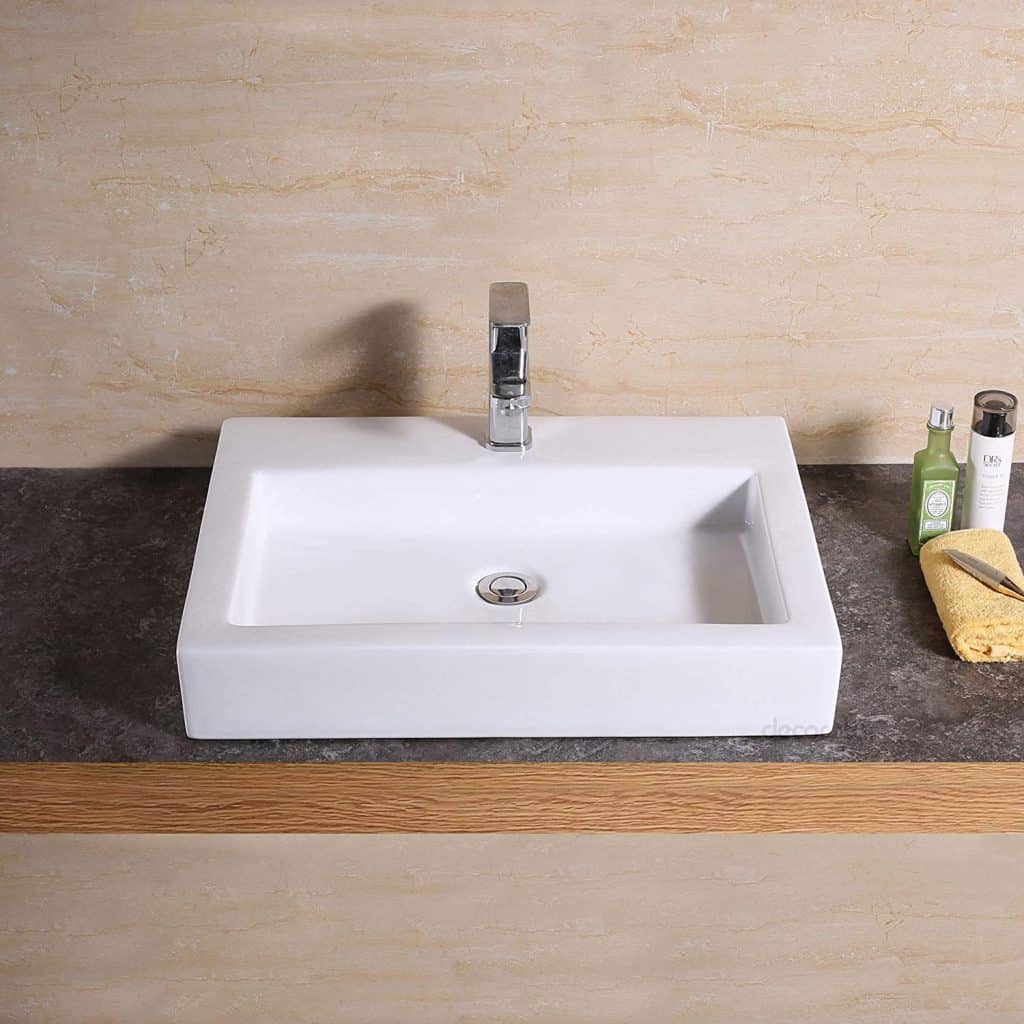
Porcelain and ceramic sinks are perfect for traditional or even contemporary kitchens. They add to the beauty of the kitchen. Besides, they are non-porous and durable materials. Porcelain sinks are easy to maintain, and they bounce back their shine with simple cleaning techniques.
Caution: Use metal items cautiously on a porcelain surface as porcelain is susceptible to scratch or chip.
Porcelain or ceramic sinks act as a mid-way, better option for a sink. They are lighter than cast iron, which is quite heavy. And heavier than stainless steel, which is super noisy yet lightweight.
Merits
- Easy to clean
- Less maintenance
- Customizable
Demerits
- May chip or crack
- Not stain or scratch-resistant
SUMMARY: Porcelain and ceramic come with less maintenance yet are susceptible to cracks. Besides, it looks extremely alluring in modular kitchens.
Fireclay
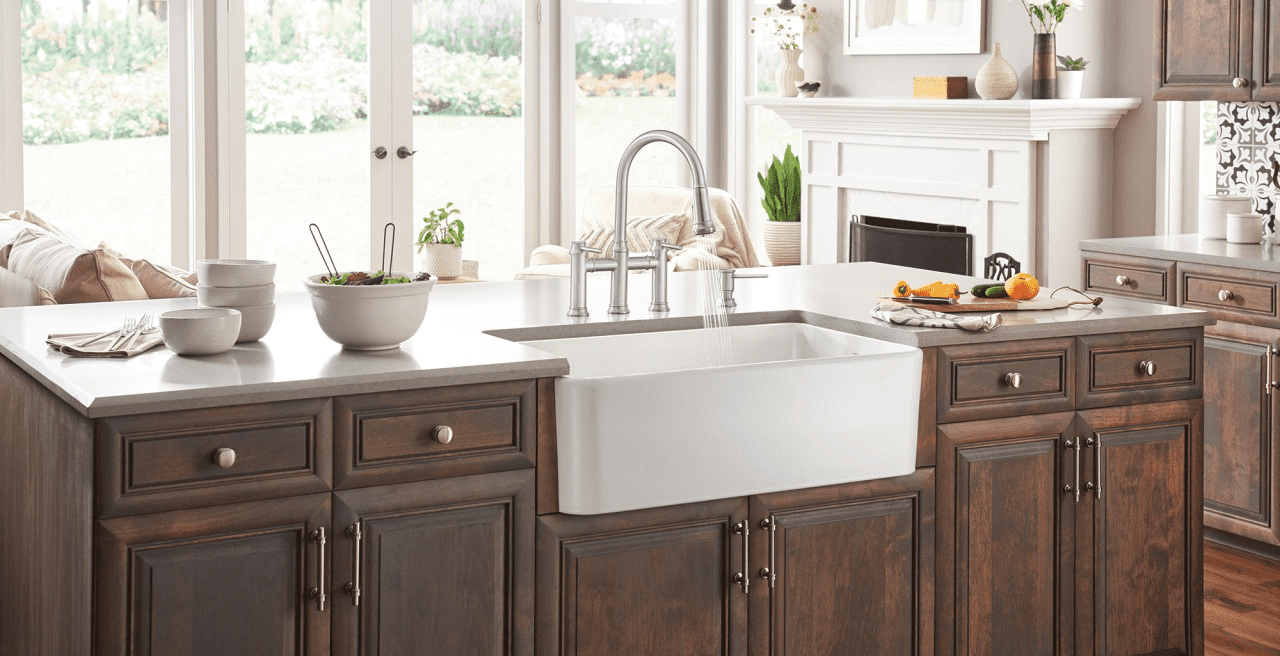
A more functional and practical material than ceramic is fireclay. It’s a mixture of porcelain and enamel which gets its glaze from firing it in a kiln.
Fireclay sinks can be available in overmount, undermount, or even in farmhouse type of sink.
Bonus Tip -Sinks with round edges are easier to clean than those with corners.
Merits
- Easy to clean and maintain
- Handcrafted sinks
- Can sustain high temperatures
Demerits
- Limited designs
- Prone to chipping and can get damaged over the time
- Susceptible to hard water stains and scratches
SUMMARY: Fireclay is a modern choice. A sink that adds an aesthetic look to your kitchen and, plus, is easy to clean and care it. However, you will find limited colors, sizes, and designs in the fireclay sink type.
Cast iron
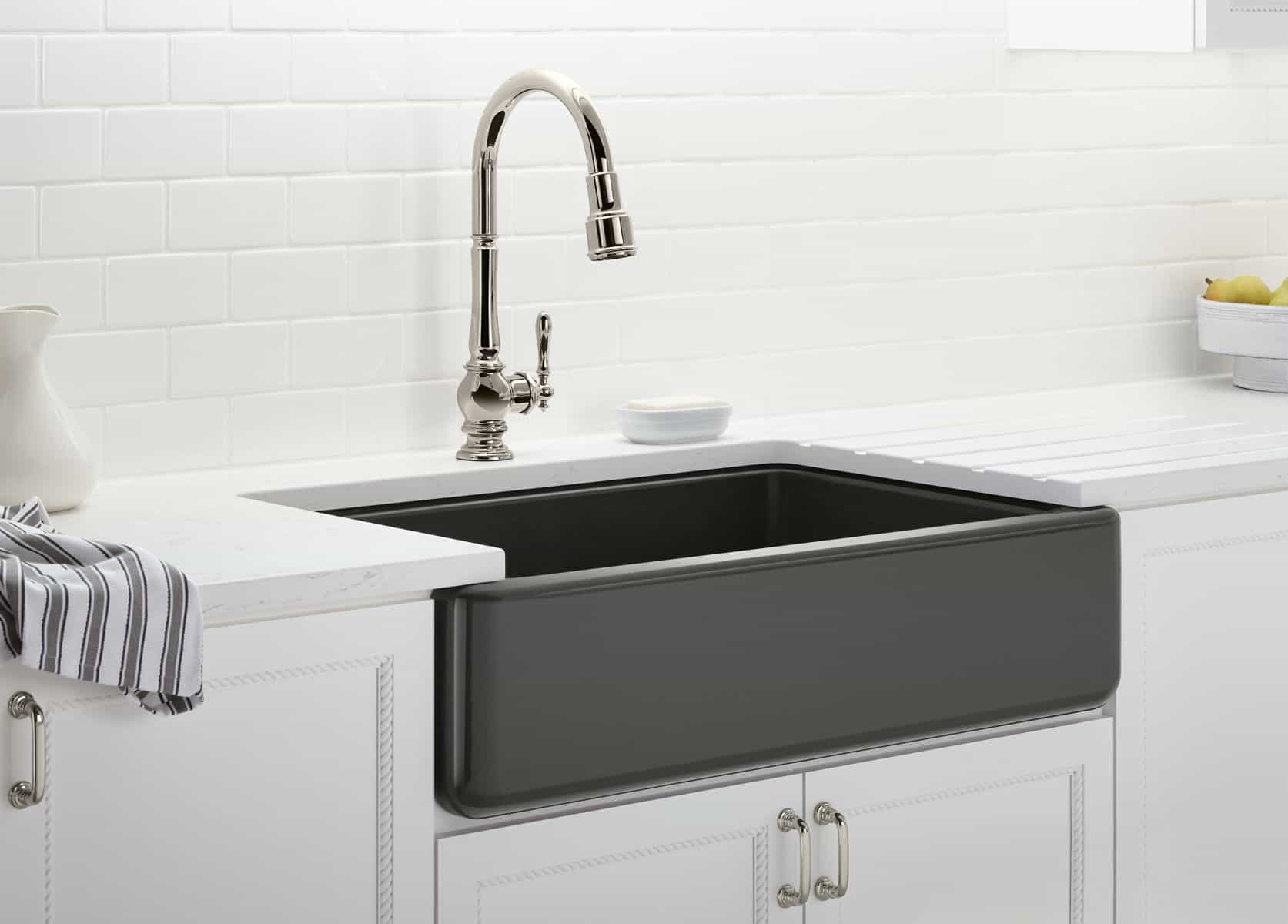
Cast iron sinks are created with a heavy composition of iron and coated with enamel porcelain. The coated enamel provides glaze and adds durability to the iron sinks.
Caution: Use utensils cautiously as they can crack, scratch, or chip your cast iron sinks.
People prefer cast iron over metal or solid surfaces because they do not dent, unlike these materials.
Additionally, it perfectly goes with your modular kitchen layouts.
Merits
- Numerous color options are available
- Easy to clean and maintain
- If used properly, sinks can last for many years
Demerits
- Prone to cracks or chips
- Heavy
- Relatively expensive
SUMMARY: Cast iron sinks are a great fit if you want easy cleaning and porcelain finish in your kitchen.
Copper

Copper kitchen sinks might not be everybody’s first choice but definitely preferred for traditional kitchen layouts. Why? It is because copper has natural antimicrobial properties and health benefits. Items made of copper have been comparatively famous since old times.
A high-quality copper sink (14 to 18 gauge model) is composed of copper (99%) and zinc (1%). This type of copper sink becomes expensive — ranging from $600 to $1,200 according to the brand, style, and size you select.
Tip: Avoid sinks with thinner gauges, which are more likely to be damaged easily. Also, avoid acidic foods and liquids on copper sinks.
Merits
- Easy maintenance
- Durable
- Not prone to stains
Demerits
- High-priced
- Requires professional installation
- Needs regular cleaning to keep the sink shining and clean
SUMMARY: Copper, an antibacterial natural kitchen sink material, provides durability and a stain-free experience. But, it comes with a price.
According to The Installation:
The kitchen sinks are divided into two types based on their installation style.
Overmount/top-mount/drop-in sinks
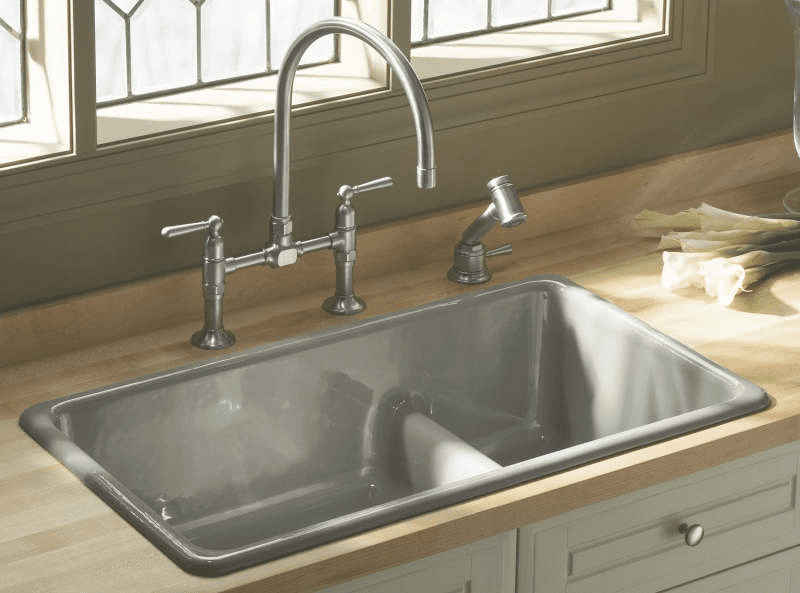
One of the common sink types you get to see is overmounted sinks. Overmount sinks are installed from above. For installing an overmount sink,
- a hole is cut into the countertop following the installation of the sink.
- Or else, it is dropped in the pre-cut hole of the countertop.
- Then, the rim of the sink and the countertop are caulked using silicone.
The edge rests upon the counter to provide stability and carries the weight of the entire sink. Regardless of the weight, you can choose any sink material that fits right for your kitchen. Hence, it is a common and preferred choice. This type of sink is also known as top-mount, drop-in, or self-rimming sink.
Merits
- Easy installation
- Relatively inexpensive
- Suitable for porous countertops that require protection
Demerits
- The rim of the sink prevents from brushing dirt and water directly into the sink
- Susceptibility to develop mold as water and debris can accumulate around the sink edges
- Not so easy to clean
SUMMARY: If you want a budget-friendly yet willing to apply some elbow grease to clean and maintain your sink, then an overmount sink can be a suitable option.
Undermount sink
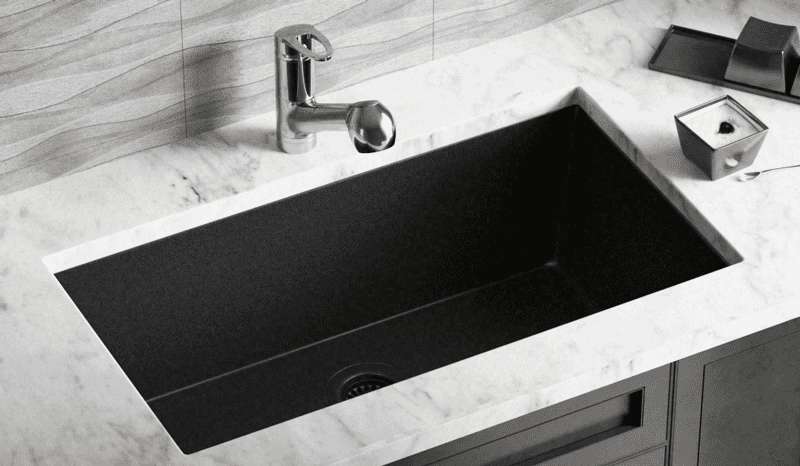
Unlike top mount, the installation of undermount sinks is from beneath the countertop with the help of special clips. In addition, undermount sinks are versatile and look perfect in any kitchen layout. As it is underneath the counter, the edge of the sink remains unexposed.
Merits
- Easiest to clean
- Provides enough countertop space
- No lip exposed creates a seamless look
Demerits
- Relatively difficult to install
- Only suitable for solid countertop surfaces. For example, granite, marble, etc.
- Quite expensive
SUMMARY: Show off your kitchen with undermount sinks. Although undermount sinks are expensive and difficult to install, they are easiest to clean.
According to The No. of Bowls:
As per your use, you can choose from the following three kitchen sink types which suit your kitchen the best.
Single bowl sink
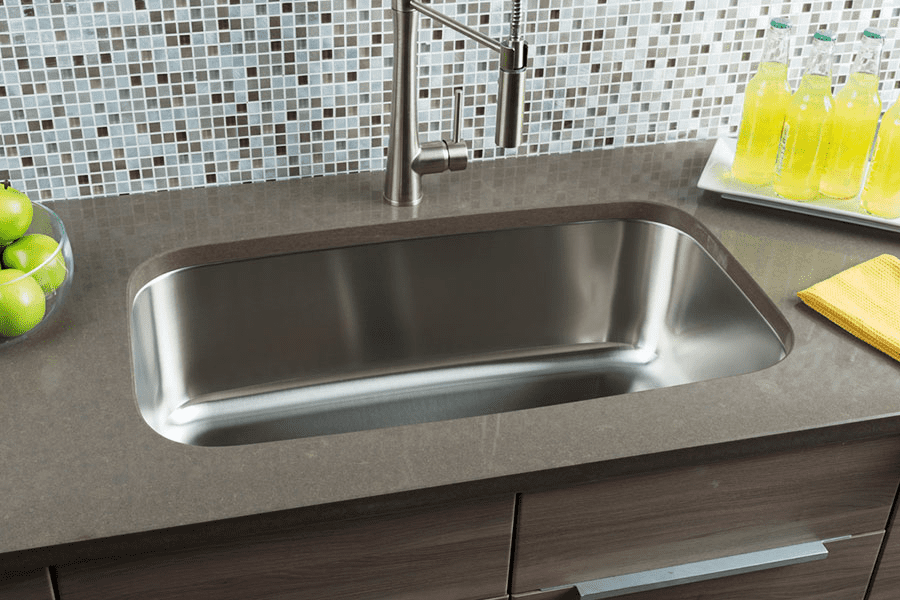
For your compact and cozy kitchen, single bowl sinks suit best. The single bowl sink does not include a separate basin. Sinks with one bowl are not ideal for cooking and cleaning simultaneously. Therefore, they are best suited for singles or small families.
Merits
- Bowl is large enough to wash large utensils
- Dirt and debris don’t splash onto the countertop
- Affordable
Demerits
- Ready a space for drying your utensils on the countertop
- No room for separating clean and dirty dishes
- Inflexible and not suitable for huge kitchens
SUMMARY: Single bowl sinks are perfect and affordable for a cozy kitchen. While keeping your countertop clean, you might have to use your counter space for drying and separating dishes.
Double bowl sink
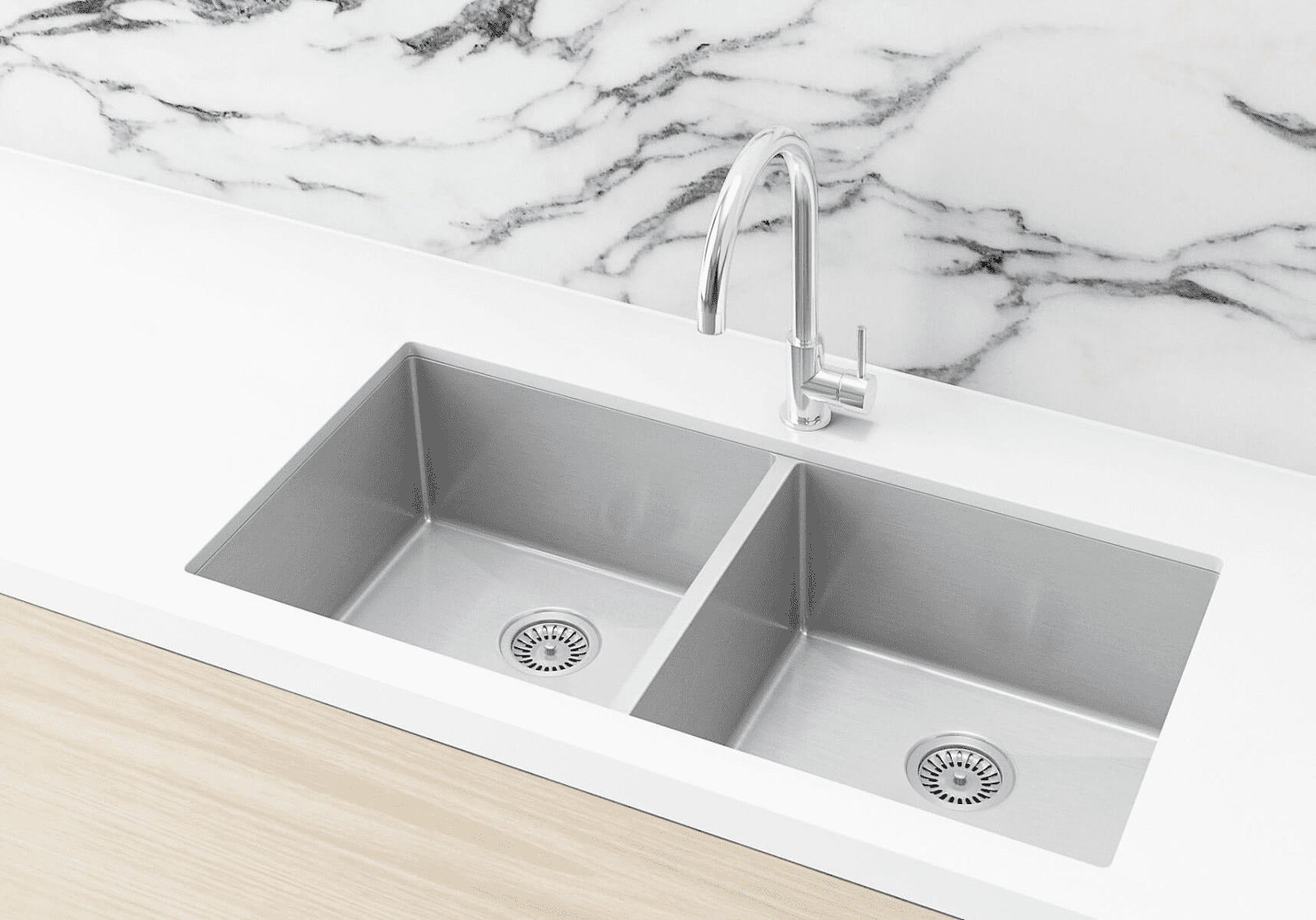
As the name suggests, double bowl sinks come with two bowls side-by-side separated by a partition. Double bowl sinks become an ideal choice if there are two cooks. The great debate continues whether single bowl sinks are better than double bowl sinks.
Merits
- Easier to use
- Allows multitasking.
- Increases counter space
Demerits
- Purchase and installation can be high-priced
- Difficult to wash large utensils
- Not suitable for smaller kitchens
SUMMARY: Double bowl sinks make your life easier and allow you to enjoy doing kitchen chores. Although, they can be difficult to install and costly.
Triple bowl sink
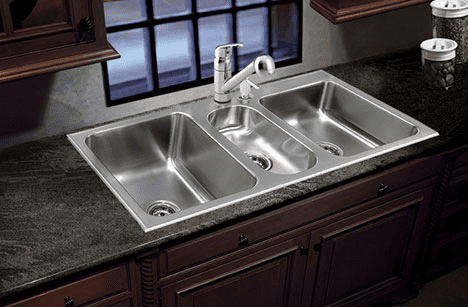
Triple bowl sinks are specially designed for people who like to do everything simultaneously. The sink includes three different compartments –2 medium bowls on either side and a relatively small bowl in the middle.
Merits
- Easy to use
- Separates the preparation, washing, and drying
Demerits
- Causes difficulty in washing large utensils
- Not available in a variety of materials or styles
- High-priced
SUMMARY: Triple bowl sinks need lots of space yet provide separate compartments for kitchen chores. Yet, they are a bit high-priced.
According to The Design:
Based on the sink’s design, there are five sink designs to choose from.
Integrated sink/Integral sink
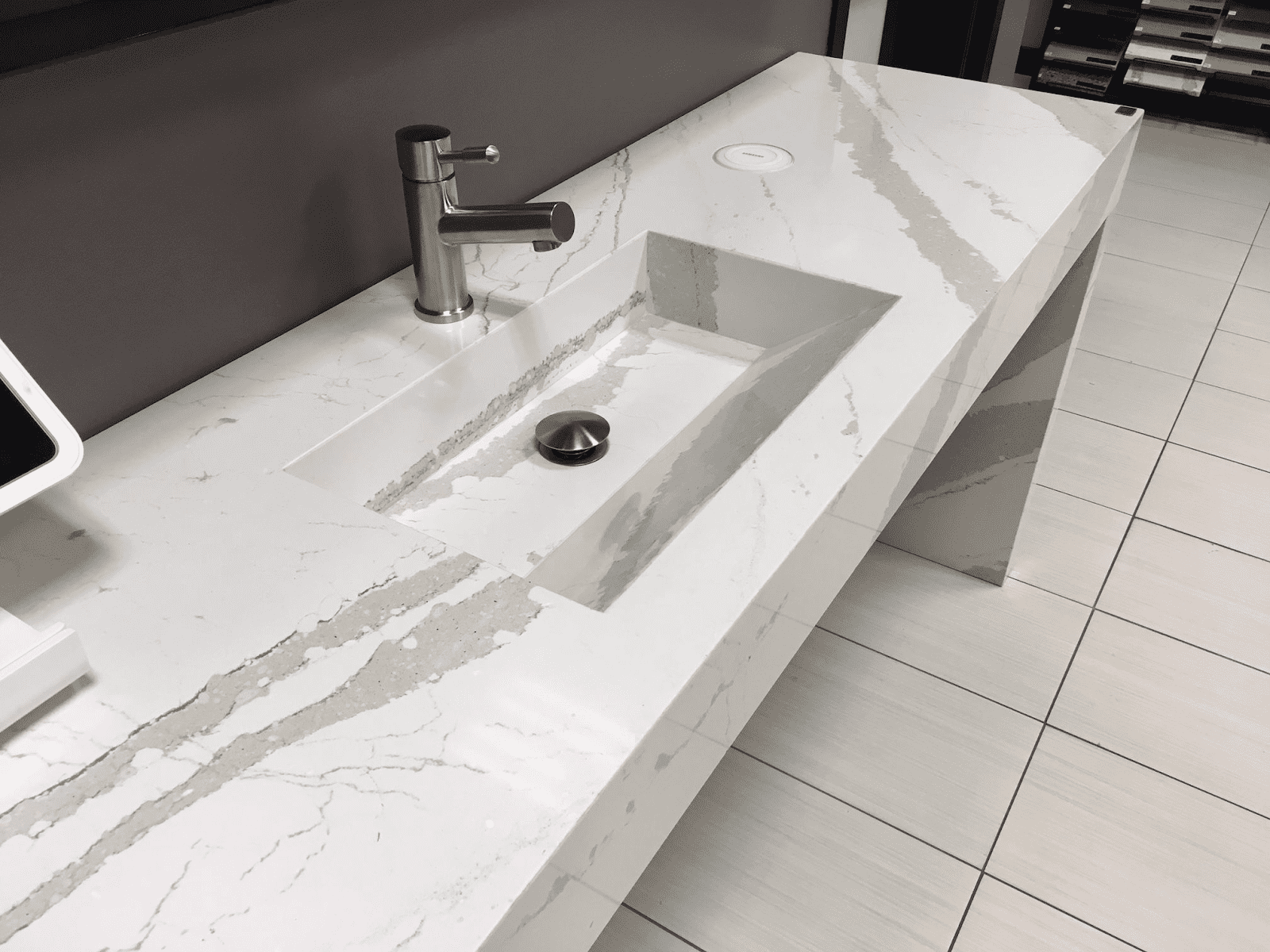
Are you looking for an all-in-one sink? The integrated sink is perfect for you.
WHY?
Because it is integrated into the counter itself. An integrated sink comes attached with the countertop. Additionally, they are of the same material as that of the countertop. They are also called integral sinks.
Merits
- Easy to clean
- Requires less maintenance
- Prevents accumulation of buildup or dirt
Demerits
- Found relatively less popular in kitchens than bathrooms
- Expensive
- Being one with the countertop, difficult to replace
SUMMARY: Integrated sinks are the same as the countertop material. If you want a monotonous look for your kitchen, you can go for integrated sinks.
Farmhouse sink/Apron sink
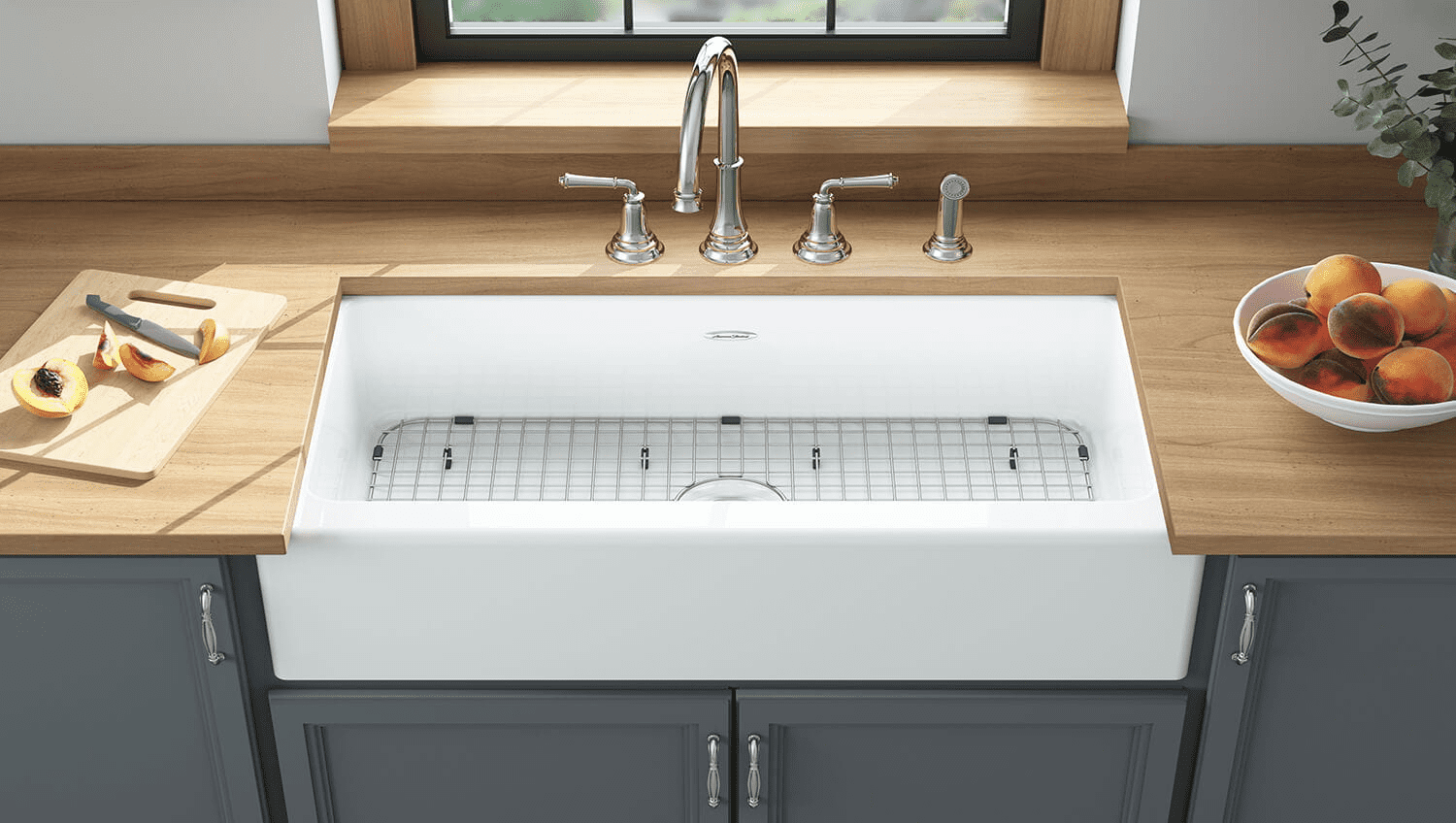
Adding an aesthetic look to your kitchen are farmhouse sinks (or apron sinks). The exposed front becomes the front of the sink and counter as well. Farmhouse sinks come with a large bowl. The depth of the bowl is more than that of the overmount or undermount sinks.
Merits
- A large bowl allows washing large utensils such as pots, pans, etc.
- Enough sink space
- The alluring look
Demerits
- Susceptible to dripping because of the less space between the sink and counter
- Fairly expensive
- Need lots of space
Note: Place a sink grid at the bottom of the sink. It will lessen the possibility of scratches and make it the easiest to clean.
SUMMARY: Farmhouse sinks are large sinks with a front wall that forms the front of the counter. Probably suitable for larger kitchens.
Drainboard sink
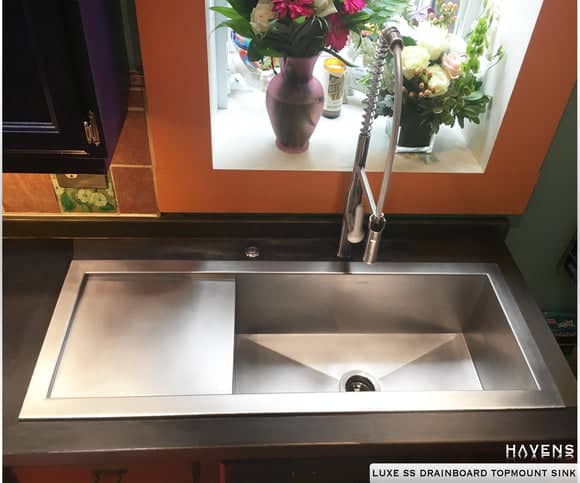
In the drainboard type of sink, you find an apron on one side or both sides of the sink. As shown in the picture, the apron covers a part of the countertop. It is for water drainage.
Drainboard style sink is best suited for people who prefer hand washing their dishes.
Merits
- Keeps your countertop clean and dry
- Saves enough counter space
- The lip will channel the water back to the sink
Demerits
- Dirt buildup in the grooves
- Bowls are small in size
- If you don’t hand wash your dishes, it might not be suitable.
SUMMARY: Drainboard sinks for suggested for people who like to hand wash their dishes.
Bar/Island/Prep sink
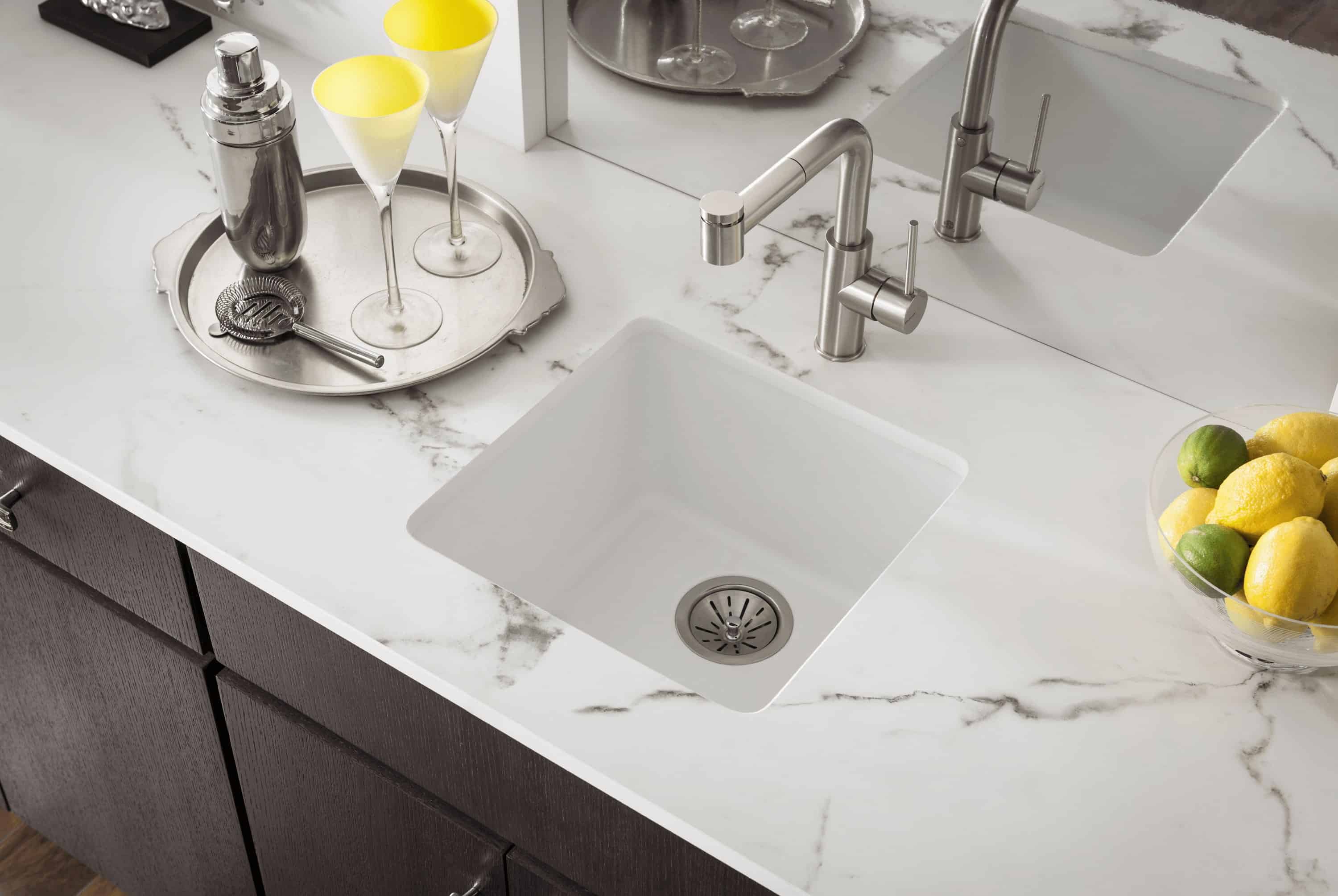
Bar sinks are comparatively smaller and shallow than the standard kitchen sinks. Generally, they have a single bowl suitable for prepping or making a drink. Hence, bar sinks are secondary sinks. This sink is also known by various names, such as island sinks, prep-sinks, or wet-bar sinks.
Merits
- Fit in a small space
- Easier to clean
- Suitable for small chores
Demerits
- Small and shallow
- Based on your kitchen layout, bar sinks may take a lot of space
- Expensive
Did you know -According to Home Advisor, bar sinks, even though being a secondary sink, installation costs around $250-$600, and plumbing installation costs around $350-$1800.
SUMMARY: Bar sinks are secondary sinks. Comparatively small than your main sink but useful for prepping, handwashing, or making a drink/
Corner sink

Corner sinks, as the name suggests, are at the corner of your counter. These are double-basin sinks placed at the corner of the counter, creating a right angle. The unused space around the sink becomes an active space if you install corner sinks.
Merits
- Saves floor space
- Saves countertop space
- Wide enough to have drying space at the center of the sink
Demerits
- Difficult to install
- Hard to clean
- High-priced
SUMMARY: Corner sinks save counter space yet are difficult to clean and expensive.
Verdict
Now, you know about all the kitchen sink types available in the market and their merits and demerits. Ultimately, the decision lies with you. You know what fits your kitchen the best. Each and every kitchen sink has its positives and negatives. Therefore, weigh the merits and demerits of every sink to help you make the right choice.
FAQs
Which Is the Best Type?
Generally, the best kitchen sink type is stainless steel double bowl sinks that are deep and large enough to clean large items. And the second is large farmhouse sinks for being large and of a different style.
For how Long Does a Sink Last?
A kitchen sink can usually last up to 10-15 years based on its usage. If you are a person who regularly cleans and maintain the sink, it may last longer.
![Granite Vs. Marble Vs. Quartz Countertops [12 Differences+Pros & Cons] Granite Vs. Marble Vs. Quartz Countertops [12 Differences+Pros & Cons]](https://houseadorable.com/wp-content/uploads/2022/03/quartz-marble.jpg)
![What Are Kitchen Sinks Made Of ? [13 Types+Pros & Cons] What Are Kitchen Sinks Made Of ? [13 Types+Pros & Cons]](https://houseadorable.com/wp-content/uploads/2022/01/Sink-MAterial.jpg)
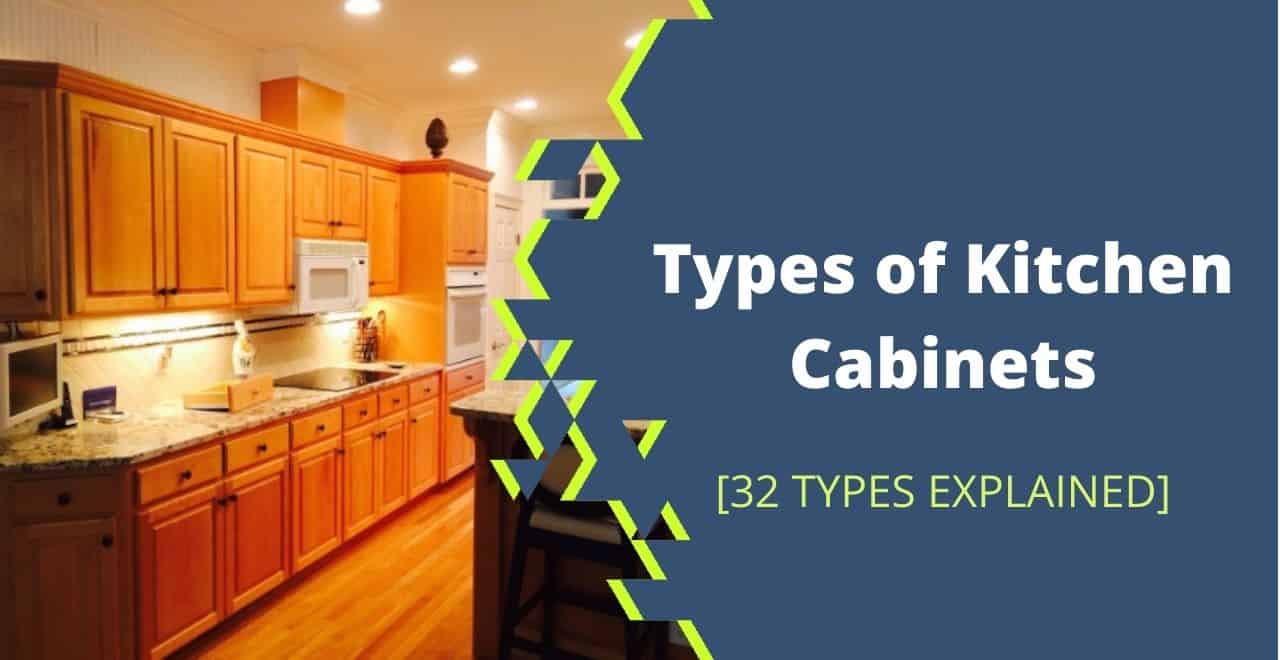
![How Much Does It Cost to Build a Kitchen Island? [Custom Made+DIY] How Much Does It Cost to Build a Kitchen Island? [Custom Made+DIY]](https://houseadorable.com/wp-content/uploads/2022/03/cost-of-kitchen-island.jpg)
![16 Types of Kitchen Faucets Explained [With Pros + Cons] 16 Types of Kitchen Faucets Explained [With Pros + Cons]](https://houseadorable.com/wp-content/uploads/2023/02/Roca_griferia_cocina_mencia_negro_DEF_900x505_acf_cropped-1@2x-250x250.jpg)
![Ceramic vs Stainless Steel Sink [A Detailed Analysis] Ceramic vs Stainless Steel Sink [A Detailed Analysis]](https://houseadorable.com/wp-content/uploads/2021/12/Ceramic-vs-ss.jpg)

![How to Choose Kitchen Cabinets [9 Important Tips Included] How to Choose Kitchen Cabinets [9 Important Tips Included]](https://houseadorable.com/wp-content/uploads/2022/10/kitchen.jpg)